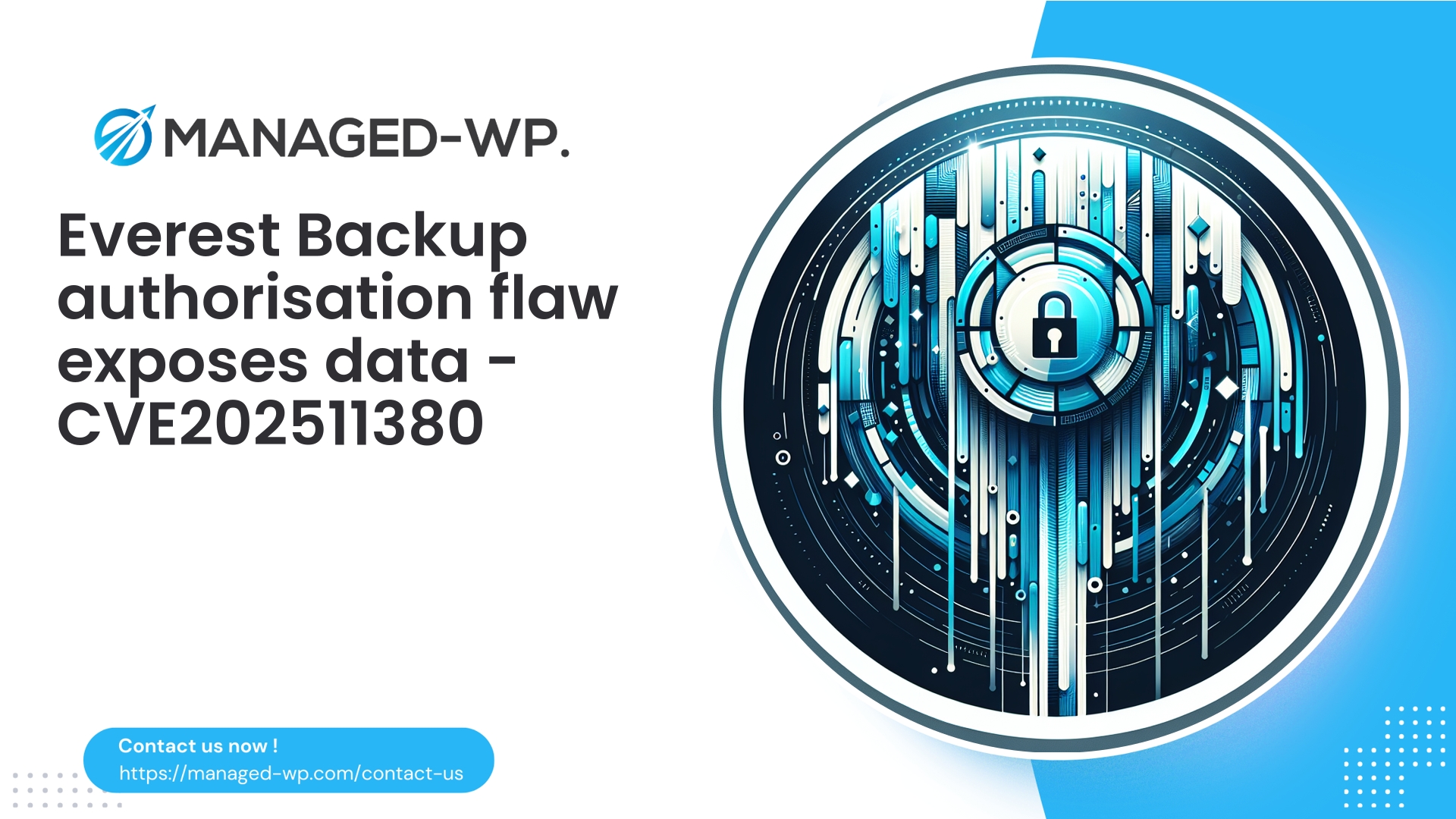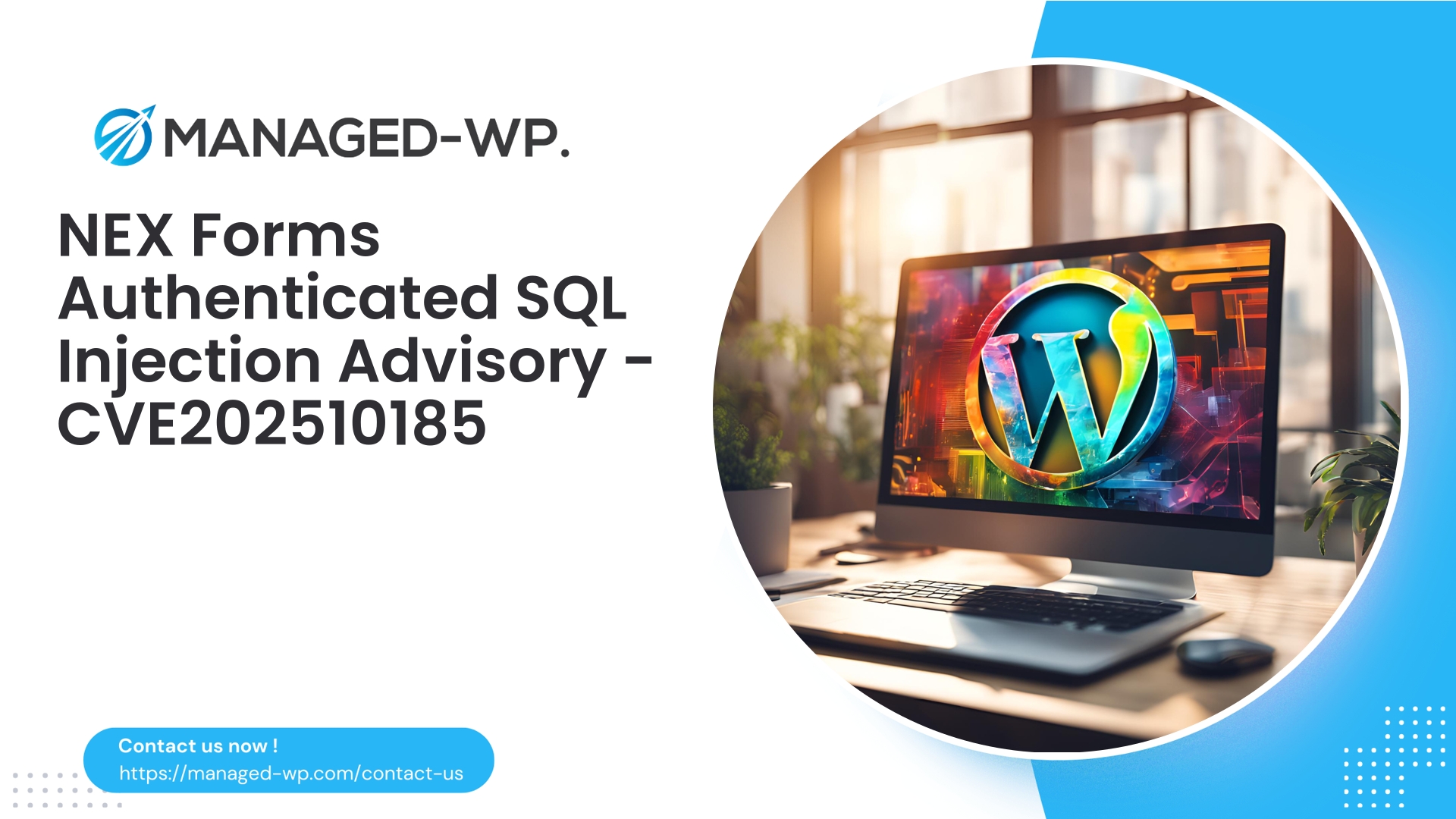| 插件名稱 | 珠穆朗瑪峰備份 |
|---|---|
| 漏洞類型 | 繞過授權 |
| CVE編號 | CVE-2025-11380 |
| 緊急 | 中等的 |
| CVE 發布日期 | 2025-10-10 |
| 來源網址 | CVE-2025-11380 |
Everest Backup 2.3.5 及更低版本 – 缺少授權會導致未經身份驗證的備份資料外洩 (CVE-2025-11380) – 網站所有者應立即採取的措施
作者: 託管 WordPress 安全團隊
日期: 2025-10-11
標籤: WordPress、安全性、漏洞、Everest Backup、CVE-2025-11380、事件回應
概述: Everest Backup 外掛程式 2.3.5 及更早版本中發現一個嚴重的存取控制漏洞 (CVE-2025-11380),該漏洞允許未經身份驗證的使用者存取敏感的備份資訊。此漏洞已在 2.3.6 版本中修復。本文詳細介紹了此風險的技術特性、潛在的利用方法、偵測和調查指南、可立即採取的緩解策略(包括透過 Managed-WP 防火牆進行虛擬修補)以及推薦的開發者修復方案,以保護 WordPress 網站的安全。
執行摘要
2025年10月10日,影響Everest Backup插件版本≤2.3.5的存取控制漏洞被公開揭露,並分配了CVE-2025-11380。該漏洞源於某些插件端點的授權檢查不足,使得未經身份驗證的訪客能夠存取備份元數據,並且在某些配置下,甚至可能下載備份檔案本身。
風險評級: 中(CVSS 5.9)。 影響: 備份檔案名稱、URL 以及可能包含敏感網站資料的備份存檔的直接存取權限已洩露。此漏洞的利用將極大地幫助攻擊者進行偵察,並促成後續攻擊,例如憑證竊取或權限提升。 Everest Backup 2.3.6 版本包含安全更新,旨在強制執行適當的存取控制。網站所有者必須優先考慮立即更新,如果無法立即更新,則應部署建議的緩解措施,包括使用 Managed-WP 的虛擬修補程式功能。
為什麼這種漏洞需要您關注
WordPress備份包含您網站的完整快照,通常包括資料庫、個人資料和使用者資料。任何向未經身份驗證的用戶洩露備份清單或直接下載連結的行為都構成重大威脅,因為攻擊者可以:
- 列出可用備份資料並選擇可能有價值的資料。
- 下載完整的資料庫匯出文件,其中可能包含敏感的使用者憑證和資訊。
- 公開網站架構、外掛程式版本和管理員使用者名稱。
- 利用竊取的資料發起有針對性的網路釣魚活動或進一步滲透網站。
備份端點必須強制執行嚴格的授權。否則,應視為高危險事件。
漏洞技術概要
- 受影響的軟體: Everest Backup WordPress 外掛
- 易受攻擊的版本: ≤ 2.3.5
- 已解決: 2.3.6
- CVE標識符: CVE-2025-11380
- 漏洞類型: 存取控制失效(OWASP A5)
- 利用存取權限: 公開(未經認證)
細節: 某些終端在未驗證使用者身分或所需權限的情況下暴露了備份資訊。因此,攻擊者可以檢索備份元數據,並且在某些情況下,可以直接下載備份文件,從而繞過適當的存取控制。
利用場景
- 備份列舉: 攻擊者請求備份列表端點,獲取檔案名稱、大小和時間戳等詳細信息,從而可以選擇要攻擊的特定備份。
- 直接備份下載: 未經身份驗證存取下載 URL 允許攻擊者檢索包含關鍵資料(包括 wp-config.php 和資料庫轉儲)的完整備份存檔。
- 自動掃描: 機器人會系統性地掃描存在漏洞的 Everest Backup 安裝,並大規模存取暴露的端點。
- 憑證收集與橫向流動: 備份恢復後,攻擊者會提取憑證、金鑰或秘密訊息,以提升權限或在網站或網路內進行橫向移動。
由於觸發該漏洞無需身份驗證,因此在網站進行修補或緩解之前,大規模利用該漏洞將構成現實的、持續的威脅。
場地所有者立即行動計劃
- 立即將 Everest Backup 更新至 2.3.6 版本。 這是最有效的保護措施。
- 如果無法立即更新,請暫時停用外掛程式。 這樣可以消除易受攻擊的端點,使其免於暴露。
- 透過 Managed-WP 防火牆啟用虛擬修補程式。 啟動針對 Everest Backup 提供的 Managed-WP 防火牆規則,以阻止未經授權的存取。
- 實作伺服器級限制: 使用 Web 伺服器設定來限制對插件目錄和相關 REST 端點的存取。
- 分析日誌以發現可疑活動。 搜尋伺服器和防火牆日誌,尋找與 Everest Backup 路徑或備份下載相關的請求。
- 輪換敏感憑證和金鑰。 如果在漏洞視窗期間存取了備份,請立即變更資料庫密碼、API 金鑰和管理員密碼。
- 保存法醫證據。 調查期間,請保留日誌、備份和其他指標的副本。
檢測潛在的探測或利用行為
若要確定您的網站是否成為攻擊目標或遭到入侵,請檢查您的伺服器和 Managed-WP 防火牆日誌,以尋找符合下列模式的請求:
- 請求
/wp-content/plugins/everest-backup/或子目錄。 - 在 REST API 呼叫下
/wp-json/everest-backup/或任何包含“珠穆朗瑪峰”的路線。 - 管理員 AJAX 操作,帶有與備份相關的查詢參數或操作名稱。
- 請求會導致產生大型檔案回應或直接下載備份檔案。
Linux 伺服器命令範例片段:
# Apache 或 nginx 日誌:zgrep -i "everest-backup" /var/log/apache2/access.log* | less zgrep -i "wp-json" /var/log/nginx/access.log* | grep -i everest zgrep "admin-ajax.". "backup\|everest"
異常跡象包括不尋常的用戶代理字串、來自可疑 IP 的請求或大文件下載。
已確認的備份下載應立即觸發全面的事件回應。
妥協指標(IOC)
- 無法辨識的 IP 位址正在存取插件或 REST 端點。
- HTTP 200 回應提供歸檔檔案(例如,content-types: application/zip, application/octet-stream)。
- 與終端機存取同時出現的意外出站流量高峰。
- 漏洞利用後的活動,例如建立新的管理員使用者或未經授權的網站修改。
一旦偵測到任何入侵指標,就必須立即輪換憑證並進行徹底的惡意軟體和完整性掃描。
緩解策略(應用廠商補丁之前)
這些措施可以暫時降低風險,一旦正式更新部署完畢,這些措施即可撤銷。務必先在測試環境中測試變更。
1. 插件停用
在 WordPress 管理背景停用 Everest Backup 插件 → 已安裝插件如果備份功能至關重要,請考慮以下替代緩解措施。
2. 基於 IP 的存取限制(Apache .htaccess)
# 在 /wp-content/plugins/everest-backup/.htaccess要求 IP 位址 203.0.113.0 和 198.51.100.14 全部拒絕拒絕所有請求,允許來自 203.0.113.0 的請求,允許來自 198.51.100.14 的請求。
3. Nginx 位置區塊
# 插入到 nginx 伺服器區塊位置 ~* /wp-content/plugins/everest-backup/ { deny all; # 或: # allow 203.0.113.0; # deny all; }
4. Managed-WP 防火牆或 ModSecurity 規則
使用如下範例所示的規則阻止對插件目錄和 REST 端點的存取:
# 阻止外掛程式資料夾存取 SecRule REQUEST_URI "@contains /wp-content/plugins/everest-backup/" \ "id:100901,phase:1,deny,log,msg:'已封鎖 Everest Backup 外掛程式路徑存取'" # 封鎖 API 存取 RERIx /wp-json/.*everest.*" \ "id:100902,phase:1,deny,log,msg:'已阻止 Everest Backup REST API 存取'"
5. 透過 WordPress 過濾器實現臨時存取控制
插入以下 mu 插件以限制對插件端點的公共存取:
<?php
// File: wp-content/mu-plugins/everest-backup-block.php
add_action('admin_init', function() {
if ( ! is_user_logged_in() && isset($_SERVER['REQUEST_URI']) ) {
$uri = wp_unslash($_SERVER['REQUEST_URI']);
if ( strpos( $uri, '/wp-content/plugins/everest-backup/' ) !== false
|| strpos( $uri, '/wp-json/everest-backup' ) !== false ) {
status_header(403);
exit('Access forbidden.');
}
}
});
注意:這只是一個臨時措施,應該進行相容性測試。
託管式 WP 虛擬修補程式:建議策略
使用 Managed-WP 保護的網站可立即啟動規則,從而保護 Everest Backup 端點:
- 阻止未經身份驗證的存取插件目錄(
/wp-content/plugins/everest-backup/*). - 限制對 Everest Backup 命名空間下的 REST API 路由的存取。
- 未經授權,禁止下載敏感備份檔類型。
- 限制備份清單或下載請求的速率,以防止濫用。
- 日誌中出現可疑的大文件回應或異常活動時發出警報。
- 如果流量不是全球性的,則實施基於地理位置/IP位址的限制。
- 對所有敏感端點請求強制執行會話 cookie 和 nonce 驗證。
虛擬修補無需修改插件程式碼即可實現快速保護,從而為執行全面的測試和更新程式提供了時間。
驗證補救措施是否成功
在修補漏洞或採取緩解措施後:
- 嘗試匿名備份清單/檢索-請求應被拒絕或不顯示任何敏感資訊。
- 檢查防火牆日誌,尋找與易受攻擊的端點相符的被阻止嘗試。
- 對外掛端點進行內部掃描,以確認沒有未經授權的資料外洩。
- 確保沒有快取層提供過時的、存在安全漏洞的內容。
長期安全建議
- 務必保持 WordPress 核心程式、主題和外掛程式為最新版本。
- 維護最新的插件清單,以便及早發現漏洞。
- 移除未使用或不活躍的插件。
- 對插件功能應用最小權限原則。
- 盡可能將備份檔案安全地儲存在伺服器之外,並對備份檔案進行加密。
- 對備份儲存實施嚴格的伺服器級身份驗證和存取控制。
- 對所有處理敏感操作的端點使用 WordPress nonce 和功能檢查。
- 保持完整的日誌記錄,並積極監控異常情況。
- 定期對關鍵插件進行安全審計和程式碼審查。
插件開發者指南
- 在所有端點上實作授權檢查,優先使用下列功能:
管理選項. - 強制執行伺服器端身份驗證-不要依賴隱蔽性。
- 使用並驗證 WordPress nonce 對 admin-ajax 和 REST API 請求的影響。
- 絕不應公開提供備份檔案;如有必要,請強制執行伺服器級身份驗證。
- 對所有輸入資料進行清理,並將資料輸出限制為僅限授權使用者。
- 臨時下載存取需要使用 HTTPS 和簽名過期連結。
- 開發自動化測試,驗證是否已封鎖未經授權的存取。
- 制定並實施負責任的漏洞揭露政策(VDP)。
已確認暴露事件回應檢查清單
- 確定並記錄請求備份資源的時間段和 IP 位址。
- 保留 Web、應用程式和防火牆日誌,以便進行取證分析。
- 立即輪換敏感憑證-資料庫密碼、API令牌、管理員憑證。
- 在適用情況下產生新的鹽值和代幣。
- 強制所有特權使用者重置密碼。
- 刪除所有受損文件,並從可信來源重建。
- 掃描網站是否有惡意軟體、Web Shell 或未經授權的管理員帳號。
- 通知受影響的利害關係人,並遵守違規報告法律。
- 事後審查,以防止再次發生並加強防禦。
樣本檢測查詢和日誌指標
- 搜尋 Apache/nginx 存取日誌,尋找傳回 200 狀態碼的外掛程式請求:
GET /wp-content/plugins/everest-backup/狀態 200
- 尋找 GET 請求中較大的 Content-Length 值(例如,> 100KB)。
- Managed-WP 防火牆日誌顯示以下規則觸發狀況:
- 規則 ID 100901:阻止 Everest Backup 插件路徑訪問
在事件回應期間,請使用伺服器或主機控制面板上的對應工具定期執行這些搜尋。
虛擬補丁的關鍵作用
隨著備份插件漏洞的公開披露,攻擊者會立即利用暴露的端點進行攻擊。透過 Managed-WP 防火牆進行虛擬修補,可以攔截並阻止針對易受攻擊路徑的惡意 HTTP 請求,從而提供至關重要的保護屏障。
優勢包括:
- 無需修改插件程式碼即可立即減少攻擊面。
- 集中式、便利的規則部署與回溯。
- 加強對攻擊企圖的監控和警報。
Managed-WP 的虛擬修補規則是專門為 WordPress 環境設計的,以確保阻止攻擊途徑,同時保持合法功能。
建議的 WAF 規則:易於理解的範例
- 阻止所有對以下目標的 GET 請求
/wp-content/plugins/everest-backup/*來自未經認證的 IP 位址。 - 拒絕匹配的 REST API 呼叫
/wp-json/*everest*/*除非透過有效會話進行身份驗證。 - 標記並封鎖查詢參數,例如
下載=或者文件=目標是備份插件資料夾。 - 將備份清單端點的請求速率限制為每個 IP 每分鐘不超過 10 次請求。
為避免意外中斷,請務必先在非阻塞模式下測試規則。
常問問題
Q:升級到 2.3.6 版本後,是否還需要採取其他措施?
答:首先及時更新。然後驗證終端行為,如果備份之前已洩露,則輪換憑證。
Q:刪除舊備份能消除風險嗎?
答:不。雖然刪除舊備份可以減少資料風險,但修補漏洞和保護備份仍然至關重要。
Q:停用 Everest Backup 會刪除備份嗎?
答:通常不會。備份檔案通常會保留在磁碟上。請查看插件文檔,如有必要,請手動刪除任何敏感文件。
負責任揭露的最佳實踐
- 請私下向插件供應商報告漏洞,或透過其發布的漏洞揭露計畫 (VDP) 報告漏洞。
- 請提供詳細的重現步驟、受影響的版本資訊以及修復建議。
- 在公開披露之前,請給予合理的答覆時間。
- 如果在供應商未回應的情況下發生主動攻擊,請通知託管服務提供者並考慮協調揭露。
使用 Managed-WP 取得基本保護(免費方案)
全面安保,免費
在 Managed-WP,我們深知 CVE-2025-11380 等漏洞帶來的迫切性。我們的免費方案為您的 WordPress 網站提供必要的保護層,包括託管防火牆、無限頻寬、高級 Web 應用防火牆 (WAF)、惡意軟體掃描以及針對常見攻擊途徑的防護。當您準備更新外掛程式和進行事件回應時,可立即部署虛擬修補程式。
需要自動清除惡意軟體或進階控制功能?了解我們為更高安全需求量身打造的標準版或專業版套餐。
來自 Managed-WP 安全專家的最後總結
備份插件承擔著至關重要的安全職責,因為它們管理網站資料的完整快照。此類組件的存取控制一旦失效,將構成最高等級的風險。必須立即進行檢測、阻止、修補、驗證和長期加固。
如果您在調查、加強或部署虛擬修補程式方面需要專家協助,Managed-WP 的安全團隊隨時準備為您提供支援。保護您的網站備份及其儲存的敏感資訊是您 WordPress 安全性策略的基石。
保持警惕,及時更新訊息,並認真監控。
— Managed-WP 安全團隊



















